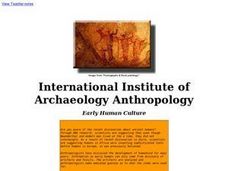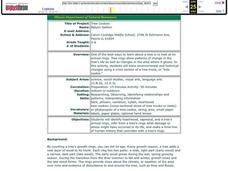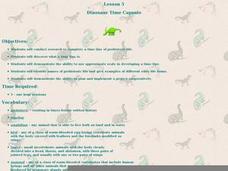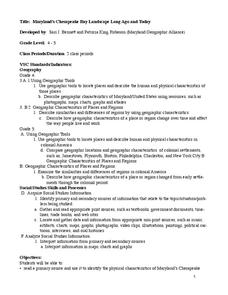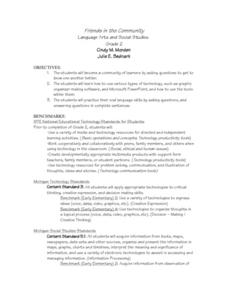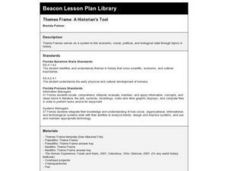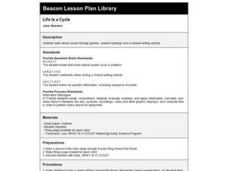New York City Department of Education
Geography and Early Peoples of the Western Hemisphere
Young historians discover the early people of the western hemisphere. The unit explores how the land changed, how it was used and homes of early Americans such as Incas, Mayans, Inuits, Aztecs, and Pueblos. Individuals also examine these...
Curated OER
International Institute of Archaeology an Anthropology
Learners research early humans and their cultures. They conduct Internet research, discuss their findings with their group, evaluate the information provided by artifacts, and create a report to present to a simulated archaeology institute.
Curated OER
Prehistoric Culture
Make prehistoric culture easy for your class to understand with this well-composed presentation. It provides timelines for the Neolithic, paleolithic age, and the agricultural revolution. Images and information on two prehistoric sites...
Curated OER
The Many Faces of Paul Robeson
Students discuss and construct timelines based on the life of author/performer/Civil Right's activist, Paul Robeson. They view photographs of him at various times in his life and discuss the roles he may have been playing at those times.
Curated OER
Where is the Trail? The Journey of Lewis and Clark
Students explore the trail followed by Lewis and Clark on their journey across the United States. In this United States History lesson, students complete several activities to establish the Lewis and Clark Expedition, including a class...
NET Foundation for Television
1850-1874 Native Americans and Settlers
Did Western settlers receiving free land from the Homestead Act realize it wasn't really free at all? Scholars investigate the impact Western expansion had on Native American culture in the mid-1800s. They use documents, timelines, and...
Curated OER
Tree Cookies
Young scholars identify heartwood, sapwood, and a tree's annual rings, infer from a tree's rings what damage or stress might have occurred in its life, and make a time-line of human history that coincides with a tree's rings.
Curated OER
Where Did Foods Originate? (Foods of the New World and Old World)
What do papayas, peanuts, pineapples, and potatoes have in common? Why, they are foods explorers brought back to the Old World. Young researchers use the Internet to investigate how New World explorers helped change the Old World's diet....
Art Authority
Art Authority K-12
Image field trips to museums that display over 1000 major works of western art. Imagine no airfare, no long lines, and only one admission fee. Imagine viewing at your convenience, with your own private docent providing information about...
Curated OER
Due Process of Law and the Jim Crow Era
Students analyze eight case studies of Supreme Court decisions regarding due process of law and their impact on American society in the early 20th century. They digest that although the 14th amendment was intended to give federal rights...
Curated OER
Immigrant Photo Analysis
Pupils examine photographs taken of immigrants during late 1800s and early 1990s in America, and identify factors involved in immigration through examination of primary documents that include statistics, trends, graphs, photographs,...
Curated OER
Dinosaur Time Capsule
Third graders research prehistoric life using educational software. They design a prehistoric life while showing the use of appropriate scale and names for the prehistoric life. They follow an internet link to participate in a virtual...
Curated OER
Letters from Lincoln
Fourth graders explore the childhood of Lincoln and pioneer life in early Indiana. Students respond to literature and write a story using historical fiction. Students explore the writings of President Lincoln and the pioneer community...
Tennessee State Museum
An Emancipation Proclamation Map Lesson
Did the Emancipation Proclamation free all slaves during the Civil War? Why was it written, and what were its immediate and long-term effects? After reading primary source materials, constructing political maps representing information...
Curated OER
Maryland’s Chesapeake Bay Landscape Long Ago and Today
Combine a fantastic review of primary source analysis with a study of Captain John Smith's influence on the Chesapeake Bay region in the seventeenth century. Your young historians will use images, a primary source excerpt, and maps...
Curated OER
Vive Le Quebec Libre!
Students use video, the Internet and CD-ROM's to investigate the cultural and linguistic traditions of Quebec, Canada. They identify the reasons behind the secession from Canada movement.
Curated OER
Friends in the Community
Second graders build a classroom community by getting to know each other better. They ask classmates various questions and use graphic organizer software and Microsoft PowerPoint. Students practice their oral language skills while asking...
Curated OER
Themes Frame: A Historian's Tool
Students research the scientific, economic, and cultural themes that connect Paleolithic and Neolithic inhabitants. They complete Paleolithic and Neolithic Theme Frames, comparing/contrasting the two cultures in an essay or Venn diagram.
Curated OER
Life Is a Cycle
Students investigate about cycles through games, shared readings and a shared writing activity. They play a game of Ring Around the Rosie to be introduced to the concept of "cycle."
Curated OER
Different! Diverse! Dynamic! Lesson 1: Late Bloomers
Young scholars examine how people grow and mature at different rates. They create a graph and a timeline to organize the data they collect.
Curated OER
Labor Needs in Colonial America
Students examine the labor needs in colonial America. Using primary and secondary resources, they explore the major events and life in the United States during colonial times. They complete a chart listing the pros and cons of a slave...
Curated OER
Digital Picture Books
Second graders create digital picture books reflecting their experiences during the school year on field trips and various classroom activities. Using digital pictures taken during the year, they write captions for each picture and...
Oregon State University
History of Western Philosophy: Bartolome De Las Casas (1484 1566)
Famous for early advocacy for indigenous peoples of America, he attempted to outlaw the econmienda system enjoyed by the Spanish colonists. Included is a time line of his activities.



